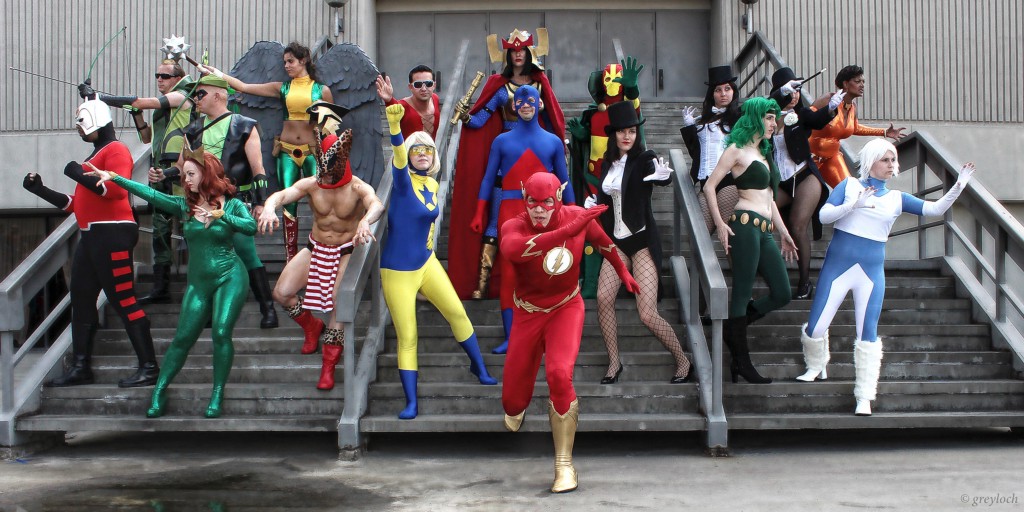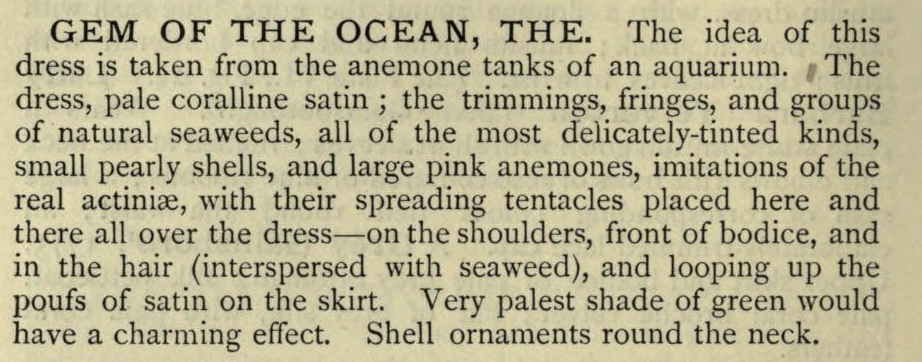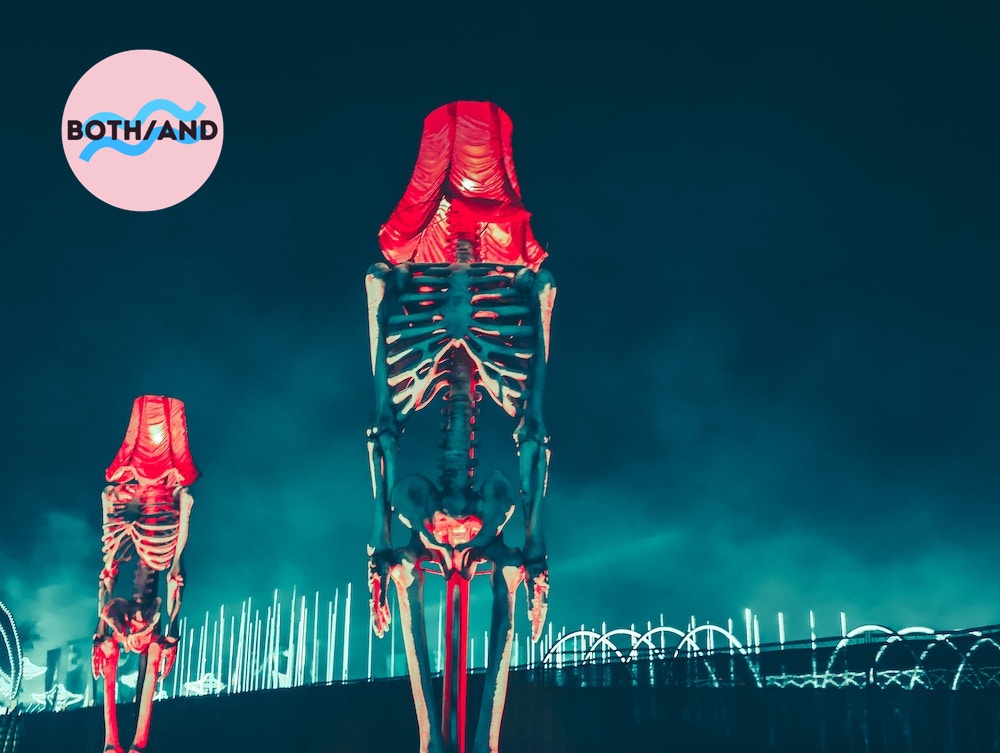Books & Culture
Dressing Up as Other People Helped Me Learn to Tell My Own Story
My religious upbringing offered me one narrative about my gender, sexuality, and body. Cosplay offered a different one.

O n the day of the April masquerade, I retrieve the supplies I purchased during the Halloween season. Liquid latex, scar wax, isopropyl myristate. I spot-clean my forearms and left shoulder with cotton pads and rubbing alcohol, ignoring the caustic smell.
My younger sister Anna, the make-up enthusiast, is standing by to assist. She selects a foam beauty blender, and I douse it in the pungent liquid latex. As I sponge the mixture onto my skin, it immediately fuses into a solid barrier that traps my arm hair beneath its surface.
For the next hour, she helps me layer on the flesh-colored scar wax, the blending foundation, and burgundy powders until the patches resemble ill-healed wounds. When we’re both satisfied, Anna sets the make-up with a finishing matte and hairspray. She’s not coming with me on my adventure — not her scene — but she still wants her work to last.
The rest of my costume: sleeveless vest, choker, skinny black pants, brown boots, gloves, and an eyepatch I’ve sewn myself. With expert precision, I tuck my wavy brown hair up into a tied-off pantyhose on my head. Anna helps me carefully tug the gold wig from South Korea over my ears. My campy, teenage geek-heart pounds. Each costume piece gets me closer not just to my chosen character, but closer to feeling powerful, feeling adventurous, beautiful, sensual. To tip-toeing toward the dimensions of myself that I otherwise never get to see.

This will be my third anime convention. By now, my Christian parents are resigned to my peculiarities, so they send me off with a promise to check in periodically via text. I punch in a quick message on my flip-phone when my high school friends and I arrive at the downtown hotel just a few miles from the Mall of America. The place is booked solid: wall-to-wall nerds on every floor. After dumping our bags in our reserved room, we race to the main lobby.
The convention’s dizzying atmosphere of color, sound, and pageantry floods red-hot excitement into my brain, my chest, my feet. For the whole weekend, I’ll be pulled in all directions: talking up plot at panels like “The Existential Philosophy of Cowboy Bebop”; fawning over strangers’ complete ownership of their chosen characters, down to the smile and strut; spending my babysitting money on DVDs and art and soft toys; and dancing, for a while at least, at the crunchy neon raves that pump audio voltage through those early-2000s nights.
Although I struggle with limited depth perception from the eyepatch, my left eye lasts a solid four and a half hours before I start to feel the strain. The burn scars hold up beautifully and attract considerable attention, but I give it out just as much. I compliment embroidery, appraise prop weapons, and revel in our triumph of translating the abstract into the flesh through this singular act of love.
In three short days, as after every convention, I will be back at school. I will bring souvenir posters and stickers to the friends who lament having been stuck in “the real world” for the weekend. And I will return to the humdrum reality of tolerating the mousy girl in the mirror.

Like most teenage misfits with odd proclivities, I did not leave what I loved behind as I moved towards adulthood. During a psychology course in undergrad, my professor opened one lecture by showing us a video taken at a previous San Diego Comic-Con. I leaned forward in my front-row seat, excited to see myself in the subject of today’s discussion. After about thirty seconds, though, a searing contempt uncurled between my ribs. The video’s narrator prowled the convention center’s main hall, singled out women and asked demeaning questions about their bodies. He lobbed barbed comments at the men. How old are you? How long have you been doing this? Is your mom okay with you working on this in her basement?
After the video, which was dubiously posited as a segue into identity and stability, the professor remarked that anyone willing to spend that much time, energy, and money on a costume must have unresolved personality issues.
A quick internet search confirms the opposite: perfectly reasonable people have been dressing up in costumes for hundreds of years. Masquerades have been culturally significant in the West since the fifteenth century. Initially, the masquerade’s purpose was both religious and political. It was during the Renaissance period, particularly in Venice, that masquerades developed purely for pleasure. The Venetian mask persists as a symbol of this lavish era. Still, in Venice, they sell masquerade masks by the cartload, although they sometimes bear Made in China stickers that the merchants don’t care to remove.
Beginning in the 1800s, costume parties became the high society pastime of both English and American gentry. Often accompanied by guide books, these costumes ranged from abstract concepts to historical figures to literary characters. Arden Holt’s 1887 book Fancy Dresses Described; Or, What To Wear To Fancy Balls details over 200 pages of original women’s costume ideas. Some are nonsensically abstract —

— while others point to the more refined elements of nature for inspiration:

As science fiction became popular among the same class of people at the turn of the century, it was only a matter of time until the enthusiasm for fancy balls birthed a new subculture. The inaugural World Science Fiction Convention was held in conjunction with the 1939 New York World’s Fair. It was here that the first green-caped “futuristicostumes” were spotted. Over the next 30 years, the art of costuming would be practiced across national, racial, gender, and class boundaries. By the 1970s, costuming was an international phenomenon. And in the 1980s, it became known as “cosplay,” the Americanization of the Japanese kosupure — abbreviations for “costume” and “play.”
As the professor quieted the class for lecture after his remark, I collected my things and slipped out. After an adolescence of eccentricity, I’d considered myself immune to judgemental comments. But the professor’s words lashed at a deeper, festering thought I’d pushed to the corner of my mind: if you like yourself best when you’re dressed up as somebody else, then who are you?

In the daily life of my early teens, modesty reigned. My private school required a strict dress code. No blue jeans, no hats, no logos larger than two inches. No sweatshirts or sweatpants. No unnatural hair or piercings beyond the earlobes. No flashy jewelry. For the girls specifically, things were more nuanced. Fortunately for my tomboy sensibilities, we were permitted to wear khakis and corduroys. Skirts and dresses had to fall to the knees or below, preferably with tights or stockings. Only light, natural-looking makeup was allowed, although we were encouraged against this. And of course, no cleavage. But all of this was subjective based on body type. A shallow scoop-necked shirt could get you pulled aside between classes and sent to the nurse for a baggy replacement if a teacher deemed it a touch too tight or a fraction too low. Discomfort was a daily nuisance: pants that were alternately too loose or too small, shirts that curled up on themselves and required constant adjusting.
My sister recalls a moment in middle school when the girls in her year were forced to endure an excruciating lecture from the principal. It’s very likely that I also received this lecture at some point, but tuned it out while reading a book on my lap under my desk. The focus of the lecture, as Anna reports it, was simple: their bodies and their budding sexualities were their greatest temptation, a doorway to lustful sin that they must be mindful of every day. They’d have to consider the familiar dress code in the context of their changing bodies. “You may think your shirt is fine, ladies, but look down.” The principal gestured broadly to her own breasts, buried under a blouse and a buttoned blazer. “Is the fabric stretched so tight that you could bounce something off there?” Some girls responded with nervous giggles, but the principal remained clinical in her delivery. “If it’s that tight, you need another shirt.”

As a teenager, I disliked my body. I was small-chested, short, something my soccer coaches called “stocky:” good for dodging and pivoting quickly, bad for clothes shopping. My face was oily and acne-prone. I wore braces. My daily solace was the tight circle of literary-minded friends with whom I discussed everything but the real world.
I don’t remember which of us introduced anime and manga into the circle, but soon our lunch and locker conversations were divided between our latest fantasy read, Japanese comics, and where to find anime episodes online. We strategically maxed out our library cards so we could each check out a different stack of manga books, then lend them to each other before the due date. We burned through entire series at lightning speed: Fullmetal Alchemist, Bleach, Naruto, Fruits Basket, Death Note. We kept ordered lists and schedules and left the little volumes in each other’s lockers with mini Post-It note reviews. Sometimes, I preemptively censored the more revealing comic panels with Post-Its, mostly for the benefit of our group’s survival. We were known for reading during class — me most of all, ahead of my peers in most subjects and perpetually bored. We’d be doomed if a teacher spotted a scantily-clad woman over someone’s shoulder mid-lecture, the private parts obscured only by a flirtatious coil of smoke.
We read nothing close to pornographic, and yet, I still had to work to quiet the tiny convicted voice that whispered wrong, wrong, wrong as I devoured stacks of manga. It was the only temptation that I indulged. There was something special in these books that celebrated and imagined the body in all extremes of motion, heroism, and sensuality.
I was not cognizant of all these factors at age thirteen, when I made my first cosplay for a local party: a cut-up shirt made to resemble a tunic, black leggings, and a carefully-traced mock tattoo on my left clavicle. True to the character I was imitating, I flattened the collar wide to display the ink and admired, with surprise, how pleasing and fair that expanse of skin was.

Of the hundreds of women’s costumes in Holt’s 1887 book, just 25 include the suggestion of trousers. Most are paired with a short skirt or petticoat. The most masculine of these are, unfortunately, Orientalist in nature:

In spite of this, it’s easy to see how the mid-century sci-fi boom coincided with a loosening of gender and sexuality norms to create the body-positive, sex-positive, gender-bending cosplay subculture that we see today (a culture that notably, still, struggles with exotifying and othering). At cosplay’s core, though, is this: the allure of wearing a different identity and working its performance for acclaim and applause. I think this was a quiet fear my parents held as I fell fiercely into the cosplay obsession — that I might try something on that I shouldn’t, and that I might like it.
At fifteen, I was head-over-heels for dozens of pretty anime boys. I loved their chic clothes, their ludicrously slender figures, and their feminine faces, irreconcilably soft and roguish. One favorite was a slick-suited bodyguard whose focal feature is a colossal shock of orange hair. I could buy orange hair with my babysitting money. The rest would be easy. I thrifted for a teen boy’s suit and matching Doc Martens. I crafted a nightstick from a light saber, plastic piping, and spray paint. And, after weeks of careful research and eager waiting, the glorious orange wig arrived. I transplanted fat and shiny goggle frames off their elastic band and onto sunglass temples so they’d stay put in the synthetic wig fiber without constraining the hair’s volume. Underneath the fuzzy mane, I saw myself in drag, and I was determined to sell it.
All weekend long at that year’s convention, people called out to me by the character’s name. I posed, quipped, and high-fived. Whether or not people could tell I was a girl was irrelevant. I loved every minute of it. And though my feet blistered from three days in the Doc Martens, I strutted and swaggered with an intoxicating pretty-boy invincibility.
And I was drawn to this performative peacocking, too, regardless of gender. In the darker parts of myself, I was struggling with same-gender attraction and that doublethink of intense denial. In the midst of this, an acquaintance that I’ll call Ash posted a photo.
Telling Queer Love Stories with Happy Endings Is a Form of Resistance
In my teen years, everyone on the Minnesota cosplay circuit was in the habit of posting their costumes-in-progress on social media. Other than my own cosplay group, I hardly knew many of these friends in the “real world.” We’d all met at events and followed each other digitally on that basis. Ash was one of these. In the local scene, Ash’s skill was unmatched. Their talent went beyond meticulous tailoring and craftsmanship. Ash could inhabit a character like no one else I knew. This was due in part to their delicate, androgynous features; features similar to those of the characters we all adored. But Ash had a flair for playing in the character’s skin, even outside the convention atmosphere.
A few weeks before a cosplay get-together, Ash uploaded a photo album of themselves wearing chosen character’s military uniform. They struck various poses, showing off the costume’s fit and craftsmanship. Near the end of the album, though, were sexy close-ups — still in character, but only partly costumed. I stared, wholly overtaken by their short, tousled hair, brows done heavy like a man’s, and their men’s shirt unbuttoned at the throat.

When I fell into cosplay, I was on the tail end of my decade in Christian school. Biblical literalism infected every area of study, from math teachers waxing rhapsodic about the divine perfection of tessellations to the more dangerous claims in our history textbooks. Bible class was just another hour of the day, along with science and music. Angels and demons were as real as Newton’s theory of gravity — and by venturing into the subculture of cosplay, I was warned, I might fall into spiritual darkness just as surely as the sun rises and sets. Yet I went, or was allowed to go, because I was an excellent Christian, and because the grand pageantry of the conventions brought me no greater joy. Cosplay is not, after all, an exclusively sexual subculture. I was trusted to avert my eyes and remove myself from any compromising situations.
During that first convention, I met openly gay people and older teens who confessed to cross-dressing regularly. I witnessed no shortage of kinky ensembles worked into the cosplay getups: ball gags, blindfolds, leather and chains, fursuits. I was sheltered, but I knew that these people were reacting against the rigid notions of gender and sexuality that I was taught to stand for. Yet I only felt shame in keeping this company during the limited hours when we were accompanied by a parent chaperone. Their presence reminded me to see this experience through the eyes of a Christ follower, and not the eyes of my own curiosity. In the parent chaperone’s absence, the flagrant flouting of societal norms was less shocking to me, and I felt less guilt for my proximity to it. Inwardly, though, I still drew a line in the proverbial sand that distanced me from those who played in the fluid sphere of the cosplay scene. My narrative was different: I was a straight Christian girl here to explore a comic book wonderland — I wasn’t here to be devious or contrarian. Cognitive dissonance, when applied with enough force, becomes a substitute truth.
Yet every Monday after every convention weekend, I spent my class periods counting out the days until next year’s event in my student planner. I showed off my souvenirs at Wednesday night youth group and endured Sunday sermons by daydreaming about my next costumes, doing mental gymnastics about how to save enough money for two new wigs. My adolescence rested on this ironic crux: that the one weekend a year I spent immersed in a fictional masquerade brought me closer to the joyful truth of myself than a life of dogmatic modesty ever did.

In a 1992 interview with Artforum, philosopher Judith Butler reiterated the thesis of her book Gender Trouble — “gender is performance” — which had been appropriated and misunderstood in the two years since its publication. “The bad reading [of Gender Trouble] goes like this,” she says. “I can get up in the morning, look in my closet, and decide which gender I want to be today…so that what you get is something like the commodification of gender, and the understanding of taking on a gender as a kind of consumerism…Performativity has to do with repetition, very often with the repetition of oppressive and painful gender norms to force them to resignify.”
I consider Butler’s observations of performative repetition and gender roles as I parse out my story — the real story, hidden underneath the dogma and denial. I try to reconcile them with the understanding that my consumerist hobby lent me of my queer identity. I first read Butler in college while away from home and church. During that time, I’d transitioned out of my anime phase and into the broader sci-fi & fantasy subculture. Ages thirteen through eighteen saw me cosplay as pretty boys and warrior women. But in college, something shifted. I was drawn to alluring and mysterious women who populated live-action dramas. Women whom I loved so dearly that I learned to walk in painful heels, apply lipstick and eyeshadow, sway my hips as I sauntered in a tight skirt. Women for whom my admiration was wrapped up in envy and desire.
As I was running out the door to my first general sci-fi convention in such a costume, I returned inside to retrieve a tiny can of hairspray from my mother’s travel case. I had grown into a well-adjusted adult in spite of my persistent peculiarities, so my parents no longer fretted over my hobbies. As I rifled through the bathroom cabinets, my father came upon me, startled. In a long black wig, fitted dark clothes, patterned tights, blood-red lips, and without my eyeglasses, I looked to him like a total stranger.
What a Cross-Dressing Lady Knight Taught Me About Gender and Sexuality
When I think of performance, my first thought is not of Butler’s “repetition of oppressive and painful gender norms”: of my long years and fearful nights praying against my desires, of the lukewarm fraternity boys I dated in college with discomfort and little interest, of the stiff and ill-fitting clothes I had to wear to school. Instead, I think first of that red-hot peacocking swagger, my true self under those repetitive, normative layers, that needed the paradoxical cover of costume to safely come out and play without consequence.
The bad reading of my life goes like this: that the four days out of the year that I spent in costume created a linear path to understanding my queerness. Of course the untangling was more agonizing and more difficult than that. I was barely out of the closet when I attended my last convention in the summer of 2014, but it was enough. For the first time, I didn’t buy a wig for my costume. I dyed my hair a deep, vibrant red that would last months after the one short weekend. And though I knew myself during that last convention, knew the confident charmer could stick around long after the rave lights were cooled and stored away, it was the only time in those seven years when I understood why putting on a costume felt like coming home.









